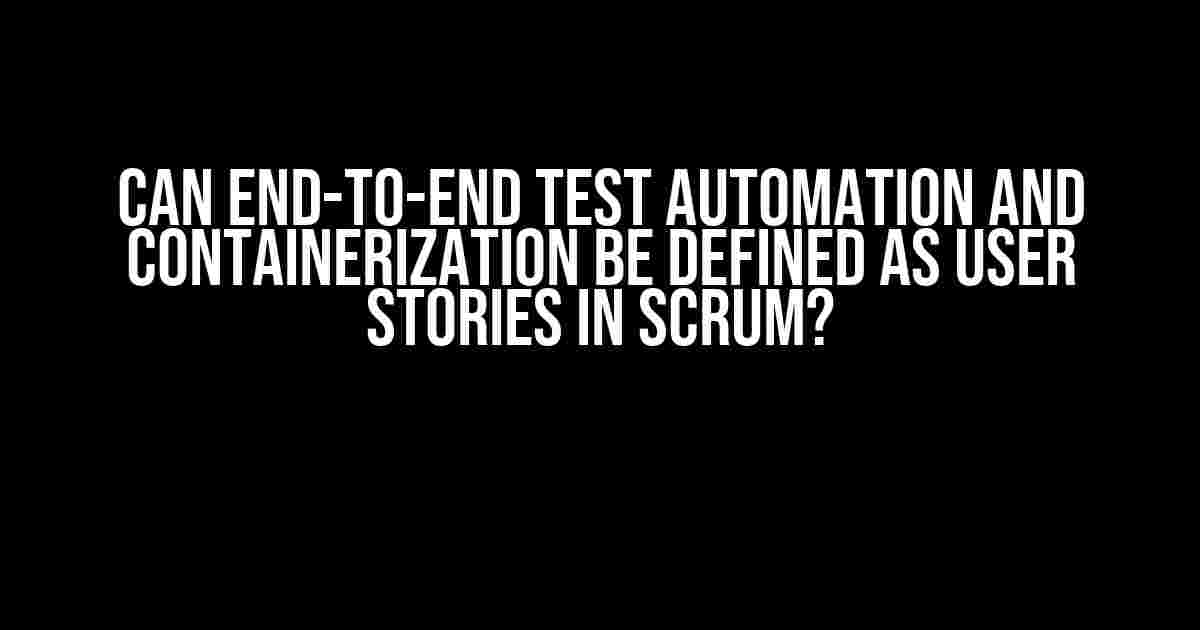In the world of agile development, SCRUM is a popular framework used to manage and complete complex projects. A crucial aspect of SCRUM is the definition and implementation of User Stories. But can we extend this concept to include end-to-end test automation and containerization? In this article, we’ll delve into the possibilities and explore the benefits of defining these concepts as User Stories.
What are User Stories in SCRUM?
In SCRUM, User Stories are the backbone of the framework. They represent a description of a software feature from an end-user perspective, written in a natural language that can be understood by both technical and non-technical stakeholders. A good User Story should adhere to the INVEST criteria:
- Independent: The Story should be self-contained and independent of other Stories.
- Negotiable: The Story should be open to negotiation and refinement.
- Valuable: The Story should provide value to the end-user or business.
- Estimable: The Story should be possible to estimate in terms of complexity and effort.
- Small: The Story should be small enough to fit within a sprint or iteration.
- Testable: The Story should have clear acceptance criteria that can be verified.
Defining End-To-End Test Automation as User Stories
End-to-end test automation involves testing a software application from start to finish, ensuring it works as expected from the user’s perspective. Can we define end-to-end test automation as User Stories? Absolutely! Here’s an example:
| User Story ID | Description | Acceptance Criteria |
|---|---|---|
| US-001 | As a user, I want to be able to login to the application using valid credentials, so that I can access the dashboard. |
|
In this example, we’ve defined a User Story for end-to-end test automation, focusing on the login functionality. The Description outlines the user’s perspective, while the Acceptance Criteria provides clear verification points for the automation script.
Defining Containerization as User Stories
Containerization involves packaging an application and its dependencies into a container, making it easy to deploy and manage. Can we define containerization as User Stories? Yes, we can! Here’s an example:
| User Story ID | Description | Acceptance Criteria |
|---|---|---|
| US-002 | As a DevOps engineer, I want to containerize the application using Docker, so that I can ensure consistent deployment across environments. |
|
In this example, we’ve defined a User Story for containerization, focusing on the deployment aspect. The Description outlines the DevOps engineer’s perspective, while the Acceptance Criteria provides clear verification points for the containerization process.
Benefits of Defining End-To-End Test Automation and Containerization as User Stories
By defining end-to-end test automation and containerization as User Stories, we can reap several benefits:
- Improved communication: User Stories provide a common language and understanding among team members, stakeholders, and customers.
- Clear requirements: User Stories ensure that requirements are well-defined, reducing misunderstandings and misinterpretations.
- Estimation and prioritization: User Stories enable teams to estimate and prioritize tasks more accurately, leading to better sprint planning and resource allocation.
- Test-driven development: By defining end-to-end test automation as User Stories, teams can adopt a test-driven development approach, ensuring that testing is integrated into the development cycle.
- Containerization simplification: Defining containerization as User Stories helps teams to break down the process into manageable tasks, making it easier to implement and maintain.
Challenges and Considerations
While defining end-to-end test automation and containerization as User Stories offers several benefits, there are also some challenges and considerations to keep in mind:
- Technical complexity: These topics may require specialized knowledge and expertise, which can lead to added complexity in writing and understanding User Stories.
- Abstract concepts: End-to-end test automation and containerization can be abstract concepts, making it difficult to define clear and concise User Stories.
- Story pointing and estimation: Estimating the complexity and effort required for these tasks can be challenging, especially for teams new to SCRUM.
- Tooling and infrastructure: Implementing end-to-end test automation and containerization may require significant investments in tooling and infrastructure, which can add to the overall project cost.
Conclusion
In conclusion, defining end-to-end test automation and containerization as User Stories in SCRUM is not only possible but also beneficial. By doing so, teams can improve communication, ensure clear requirements, and adopt a test-driven development approach. However, it’s essential to be aware of the challenges and considerations involved, and to adapt the approach to the team’s specific needs and expertise.
Remember, the key to successful implementation lies in: 1. Clear and concise User Story definitions 2. Effective communication among team members and stakeholders 3. Adapting the approach to the team's specific needs and expertise
By embracing this approach, teams can unlock the full potential of SCRUM and ensure that end-to-end test automation and containerization are integral parts of the development process.
Frequently Asked Question
Get ready to dive into the world of SCRUM and agile development, where the boundaries of end-to-end test automation and containerization meet the realm of user stories!
Can end-to-end test automation be defined as a user story in SCRUM?
Yes, end-to-end test automation can be defined as a user story in SCRUM. In fact, it’s a great way to ensure that the development team is building a testable product. By defining automated tests as user stories, the team can prioritize and estimate the effort required to implement them, just like any other feature or functionality. This approach helps to ensure that automated testing is an integral part of the development process, rather than an afterthought.
How do you write a user story for containerization in SCRUM?
When writing a user story for containerization, it’s essential to focus on the benefits it brings to the product or system. For example, “As a developer, I want to ensure that our application can be easily deployed and managed in a containerized environment, so that we can reduce deployment time and improve scalability.” This user story defines the value of containerization in terms of its impact on the development team and the product, making it easier to prioritize and estimate.
What are the benefits of defining end-to-end test automation as user stories in SCRUM?
Defining end-to-end test automation as user stories in SCRUM brings several benefits, including improved test coverage, faster testing, and reduced testing costs. By prioritizing automated tests alongside other features and functionalities, the development team can ensure that the product is thoroughly tested and meets the desired quality standards. Additionally, user stories for automated testing help to clarify the testing requirements, making it easier to estimate the effort required and allocate resources accordingly.
Can containerization be considered as a technical debt in SCRUM?
Yes, containerization can be considered as a technical debt in SCRUM, especially if it’s not implemented initially and is added later in the development process. Implementing containerization can require significant changes to the application architecture, deployment processes, and infrastructure. By defining containerization as a technical debt, the development team can acknowledge the work required to implement it and prioritize it accordingly, ensuring that it’s addressed in a timely and efficient manner.
How do you prioritize user stories for end-to-end test automation and containerization in SCRUM?
Prioritizing user stories for end-to-end test automation and containerization in SCRUM should be based on their business value and impact on the product or system. Consider factors such as the frequency of deployments, the complexity of the testing requirements, and the benefits of containerization in terms of scalability and deployment time. By prioritizing these user stories alongside other features and functionalities, the development team can ensure that they’re addressing the most critical needs of the product and stakeholders.


